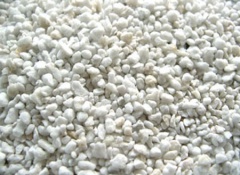Difference between revisions of "Perlite"
(→Shipment / Storage) |
|||
| Line 7: | Line 7: | ||
| risk factors = See text | | risk factors = See text | ||
}} | }} | ||
| + | __TOC__ | ||
==Description / Application== | ==Description / Application== | ||
Perlite is an amorphous volcanic glass that has a relatively high water content, typically formed by the hydration of obsidian. It occurs naturally and has the unusual property of greatly expanding when heated sufficiently. It is an industrial mineral and a commercial product useful for its light weight after processing.<br><br> | Perlite is an amorphous volcanic glass that has a relatively high water content, typically formed by the hydration of obsidian. It occurs naturally and has the unusual property of greatly expanding when heated sufficiently. It is an industrial mineral and a commercial product useful for its light weight after processing.<br><br> | ||
Revision as of 15:30, 18 February 2014
| Infobox on Perlite | |
|---|---|
| Example of Perlite |  |
| Facts | |
| Origin |
|
| Stowage factor (in m3/t) | - |
| Humidity / moisture | - |
| Ventilation | - |
| Risk factors | See text |
Perlite
Description / Application
Perlite is an amorphous volcanic glass that has a relatively high water content, typically formed by the hydration of obsidian. It occurs naturally and has the unusual property of greatly expanding when heated sufficiently. It is an industrial mineral and a commercial product useful for its light weight after processing.
Some perlites are of intrusive origin (dikes), but others constitute major portions of lava flows. These glassy rocks may grade into nearly completely crystalline volcanic types. Like obsidian, they may contain large crystals (phenocrysts) of quartz, alkali feldspar, plagioclase feldspar, and, in some cases, biotite or hornblende; where phenocrysts are abundant the rock passes into vitrophyre.
Perlite is a type of rhyolite with a chemical composition, index of refraction, and specific gravity similar to those of obsidian. Its water content, however, is considerably higher (generally 3 to 4 percent); much of it is absorbed, subsequent to consolidation, from the sea or from wet sediments into which the perlite was intruded.
Devitrification, or conversion of the glass to a microscopically fine crystalline aggregate, is usually initiated spontaneously along cracks or at the surfaces of phenocrysts and crystalline bodies (spherulites). Some minutely crystalline rocks show well-developed perlitic structure and undoubtedly represent completely devitrified perlite. The localization of spherulites along curved and concentric bands in certain glass-free rocks suggests a devitrified perlite with spherulitic growth along the perlitic cracks.
When it reaches temperatures of 850–900°C, perlite softens (because it is a glass). Water trapped in the structure of the material vaporises and escapes, and this causes the expansion of the material to 7–16 times its original volume. The expanded material is a brilliant white, due to the reflectivity of the trapped bubbles. Unexpanded ("raw") perlite has a bulk density around 1100 kg/m3 (1.1 g/cm3), while typical expanded perlite has a bulk density of about 30–150 kg/m3 (0.03-0.150 g/cm3).
Because of its low density and relatively low price, many commercial applications for perlite have developed. In the construction and manufacturing fields, it is used in lightweight plasters and mortars, insulation and ceiling tiles.
In horticulture, perlite can be used as a soil amendment or alone as a medium for hydroponics or for starting cuttings. When used as an amendment it helps prevent water loss and soil compaction.
Perlite is an excellent filter aid. It is used extensively as an alternative to diatomaceous earth. The popularity of perlite usage in this application is growing considerably worldwide. Perlite filters are fairly commonplace in filtering beer before it is bottled.
Small quantities of perlite are also used in foundries, cryogenic insulation, as a lightweight aggregate in mortar (firestop) and in ceramics as a clay additive. It is also used by the explosive industry.
Shipment / Storage
Analysis of Perlite:
- 70-75% silicon dioxide: SiO2
- 12-15% aluminum oxide: Al2O3
- 3-4% sodium oxide: Na2O
- 3-5% potassium oxide: K2O
- 0.5-2% Iron Oxide: Fe2O3
- 0.2-0.7% magnesium oxide: MgO
- 0.5-1.5% calcium oxide: CaO
- 3-5% loss on ignition (chemical / combined water)
The product is mostly shipped in bulk.
Risk factors
Wet damage and contamination.











